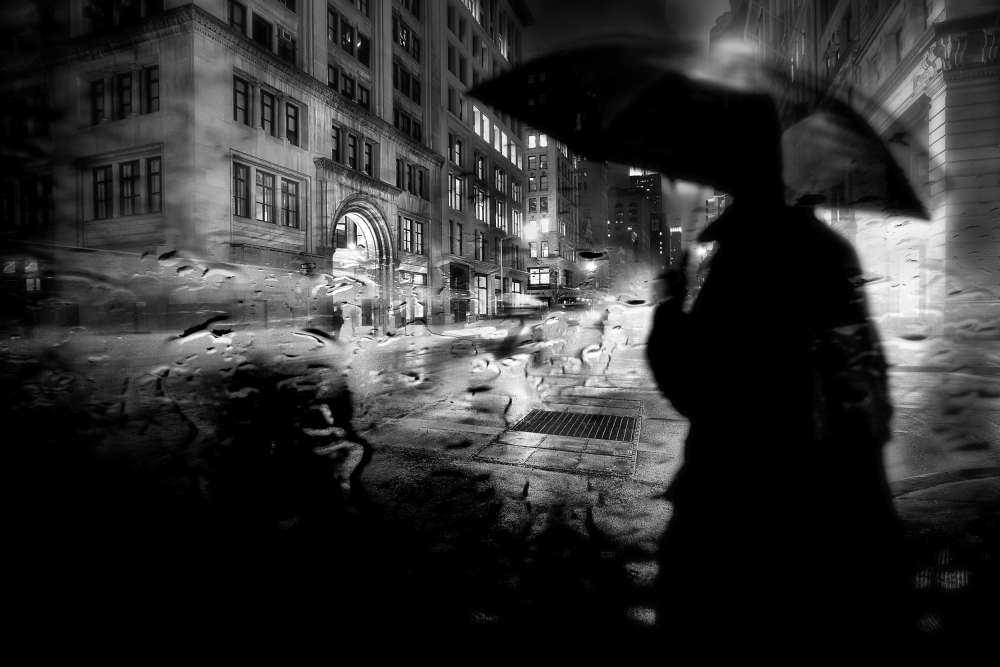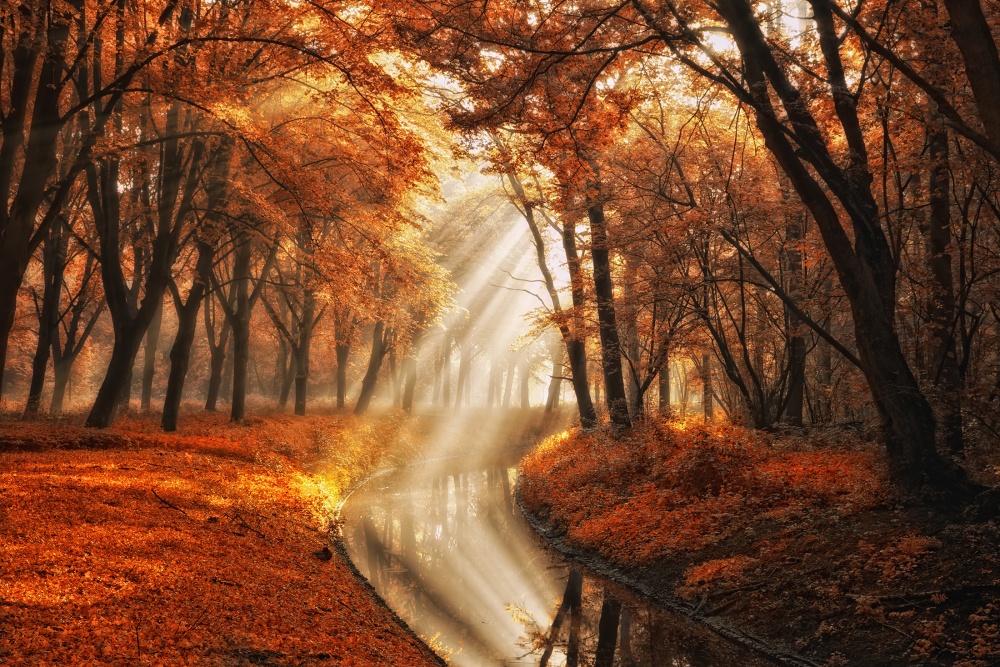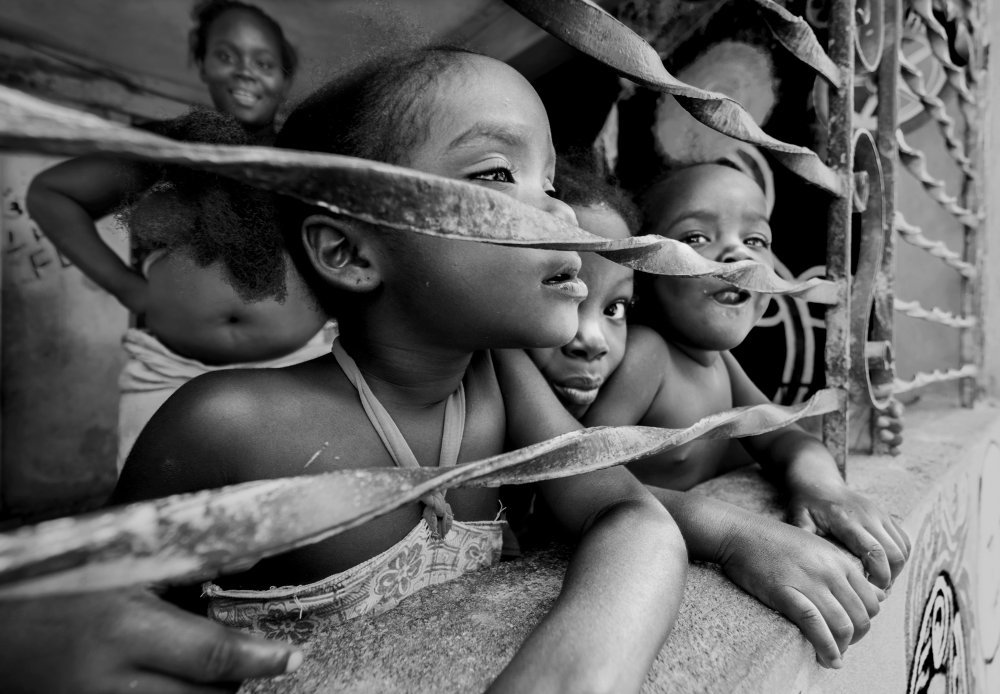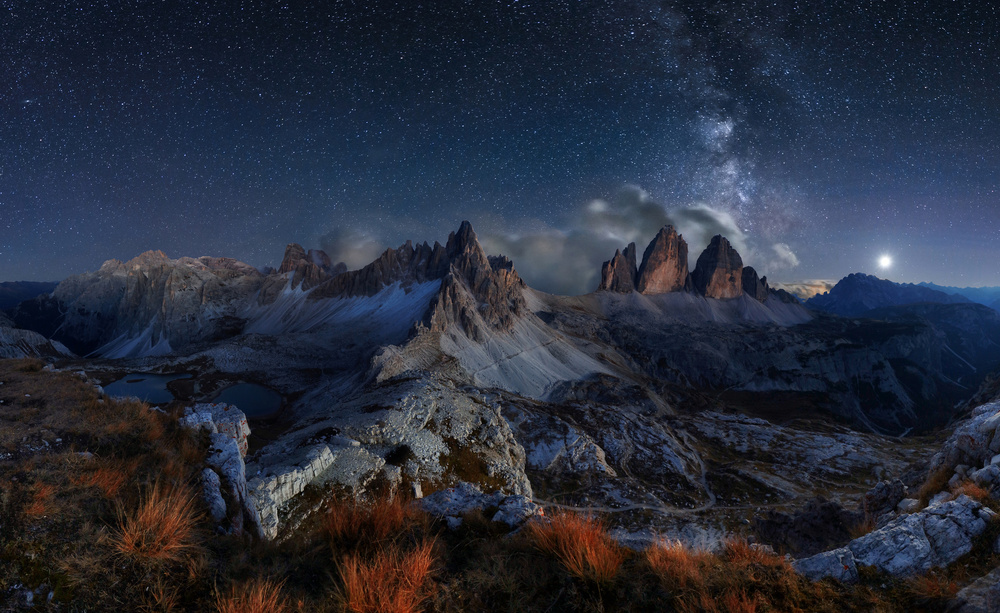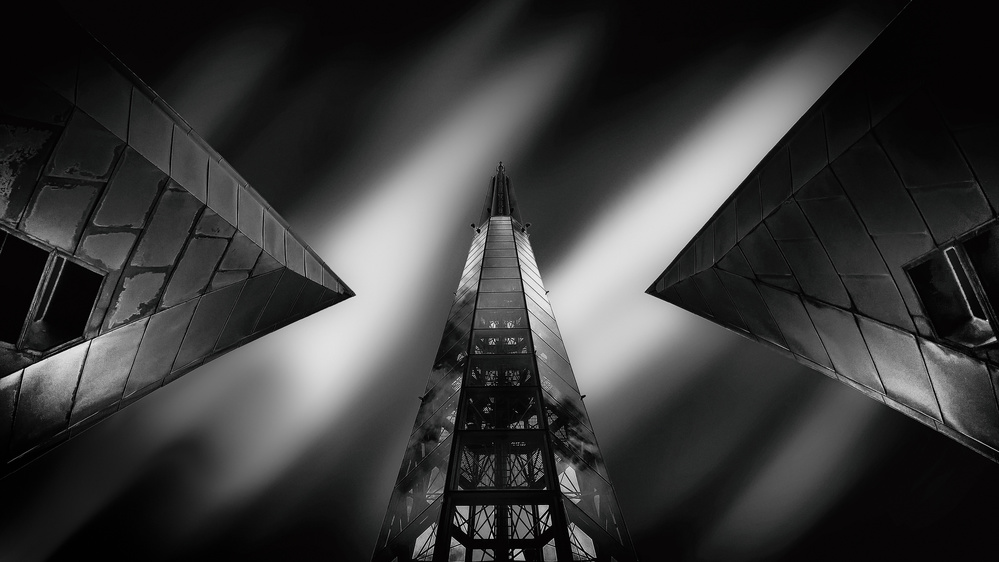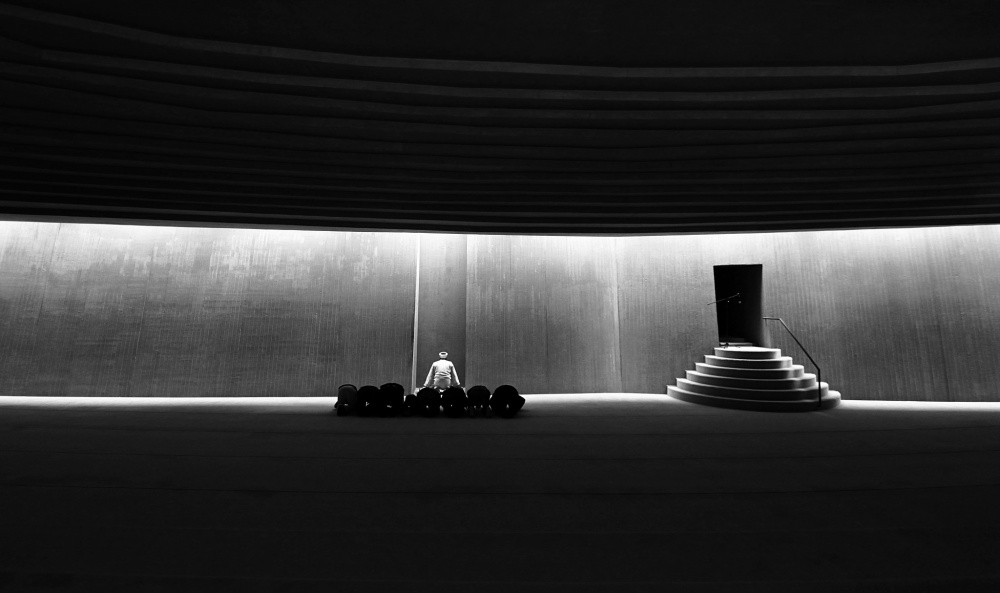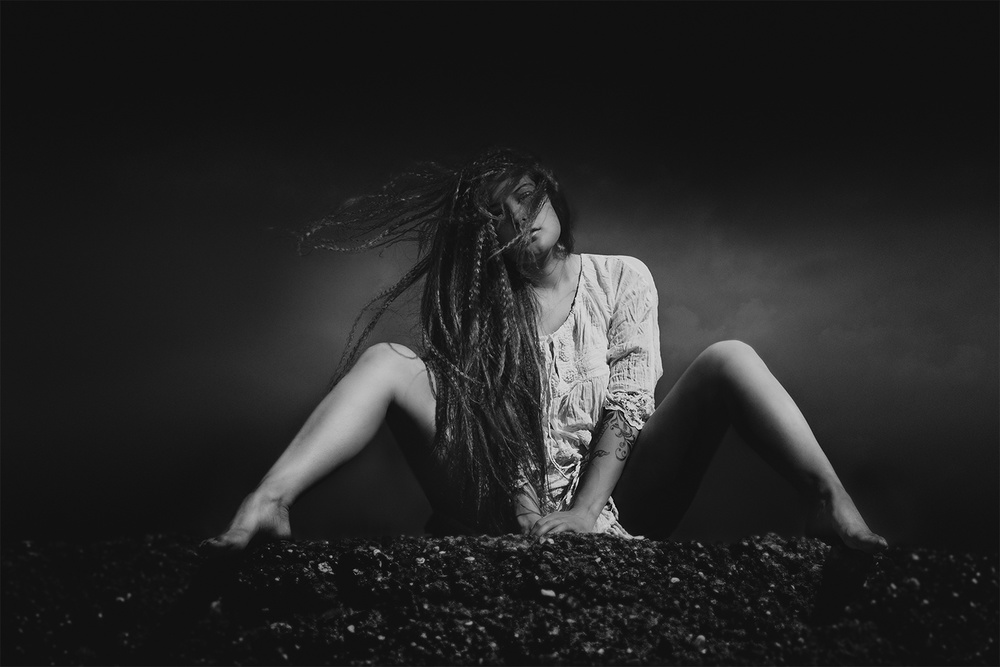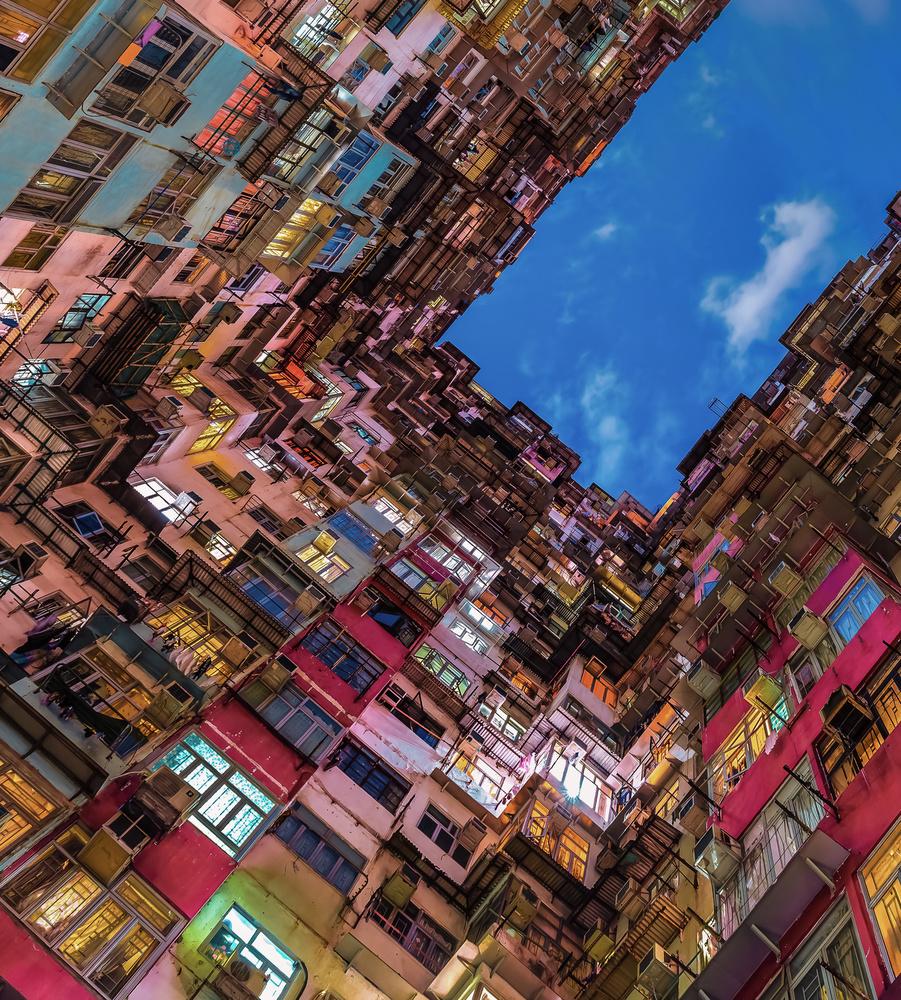Photographers
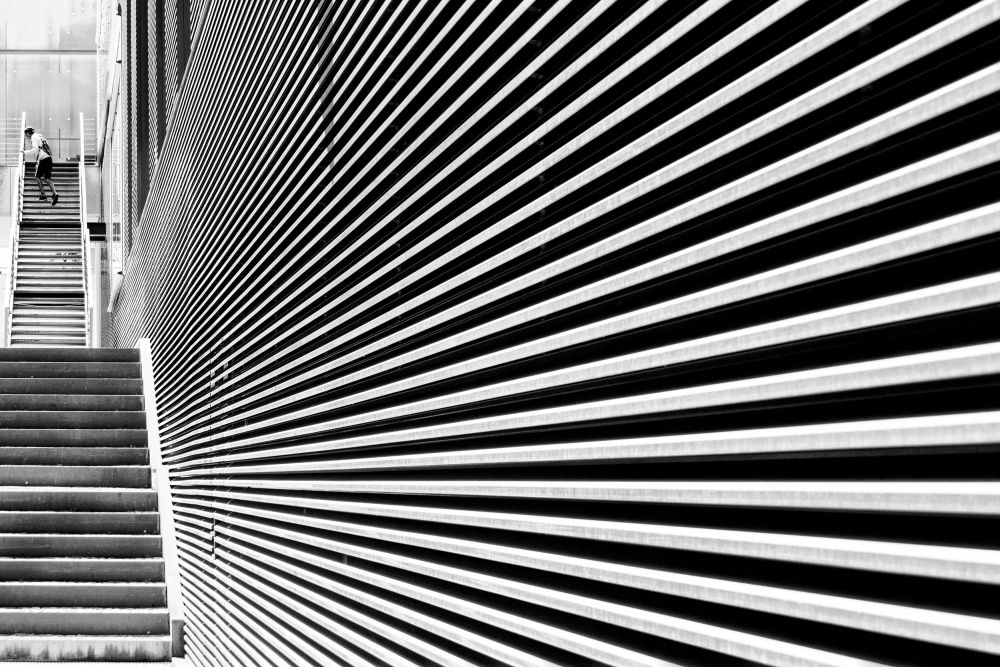
Fun Time in Babylon
1x Blog-Photographers' .
Street photography requires a different attitude from other photographic genres. It is necessary to be very attentive to detail, the surroundings and the events that are happening all around you.
I do not know from where I draw my inspiration, but I particularly enjoy street photography. I often try to play with the lines, shadows, lights and peculiarities of the environment, preferably with a human element. That's why this was such a great place to take pictures.
I took a few photos of my son alongside the building and liked the results. While my son wandered around, I stayed to explore the potential of the place. One of the walls of the building consisted of metal “blades,” and I thought that if I moved in closer, I could photograph this structure along the entire wall. I really liked the effect, but wanted to catch someone climbing the stairs next to the wall. I waited for my son and took the picture when he reappeared. I especially like this photo because the lines of the building occupy almost the entire frame and they lead the eye up the stairs to my son.
In street photography, it is important to look with a discerning eye while trying to foresee a possible photographic opportunity. It is necessary to have patience and wait for the right moment. There are a number of factors to consider in street photography. Consider environmental elements to use for composing a possible picture — lines, points of interest and forms. Another factor is weather — light, shadows, rain, sun, clouds or clear skies. I like to add a human presence, but I always wait for the right person in the right place while trying to do something different. It is necessary to learn to rely on our own way of seeing the world, and above all, it is important that the photo provides a way for us to find ourselves.
Although I liked this photo, I took several others in the same location with different perspectives and framing. If I returned to the same place, I know I could try even more angles and explore other situations, producing a completely different image. There is no such thing as a “perfect image," and I believe one can always improve something.
. '
by laura mexia
Street photography requires a different attitude from other photographic genres. It is necessary to be very attentive to detail, the surroundings and the events that are happening all around you.
My son and I love to walk around and discover new places to photograph. This photo was taken during a trip to Lisbon, in a modern residential area in Parque das Nações (Expo 98). I was fascinated by the photographic possibilities that the architecture of these buildings could offer.
I do not know from where I draw my inspiration, but I particularly enjoy street photography. I often try to play with the lines, shadows, lights and peculiarities of the environment, preferably with a human element. That's why this was such a great place to take pictures.
I took a few photos of my son alongside the building and liked the results. While my son wandered around, I stayed to explore the potential of the place. One of the walls of the building consisted of metal “blades,” and I thought that if I moved in closer, I could photograph this structure along the entire wall. I really liked the effect, but wanted to catch someone climbing the stairs next to the wall. I waited for my son and took the picture when he reappeared. I especially like this photo because the lines of the building occupy almost the entire frame and they lead the eye up the stairs to my son.
"It is necessary to learn to rely on our own way of seeing the world, and above all, it is important that the photo provides a way for us to find ourselves."
In street photography, it is important to look with a discerning eye while trying to foresee a possible photographic opportunity. It is necessary to have patience and wait for the right moment. There are a number of factors to consider in street photography. Consider environmental elements to use for composing a possible picture — lines, points of interest and forms. Another factor is weather — light, shadows, rain, sun, clouds or clear skies. I like to add a human presence, but I always wait for the right person in the right place while trying to do something different. It is necessary to learn to rely on our own way of seeing the world, and above all, it is important that the photo provides a way for us to find ourselves.
Although I liked this photo, I took several others in the same location with different perspectives and framing. If I returned to the same place, I know I could try even more angles and explore other situations, producing a completely different image. There is no such thing as a “perfect image," and I believe one can always improve something.
POST PROCESSING
I post-processed my photo in Adobe Camera Raw. I use Camera Raw as much as I can, and only if I am not satisfied will I export my photographs to Photoshop to work on the black and white processing.
1) In Camera Raw, the following values were set in the Basic panel: White Balance Temperature 5350K, Tint +15, Exposure +1.25, Recovery 12, Fill Light 19, Blacks 25, Brightness +119, Contrast +50 and Clarity +30.
2) In the Tone Curve — Parametric panel, I set Highlights –39, Lights –59, Darks –31 and Shadows +27.
3) In the Tone Curve — Point panel, I selected Medium Contrast and set the Black Point (Input) to 2 and the White Point (Output) to 254.
4) In the Detail panel I adjusted Sharpening to Amount 25, Radius 1.7, Detail 38 and Masking 69.
5) Also in the Detail panel I set Noise Reduction to Luminance 5, Luminance Detail 0, Luminance Contrast 0, Color 50 and Color Detail 0.
6) In the HSL/Grayscale panel, under Grayscale Mix, I set the following values: Reds –9, Oranges –18, Yellows –21, Greens –26, Aquas –19, Blues +8, Purples +15 and Magentas +4.
7) Finally, in the Lens Corrections panel, under the Manual tab, I made these settings: Horizontal +17, Rotate –2.3 and Scale 108.
1) In Camera Raw, the following values were set in the Basic panel: White Balance Temperature 5350K, Tint +15, Exposure +1.25, Recovery 12, Fill Light 19, Blacks 25, Brightness +119, Contrast +50 and Clarity +30.
2) In the Tone Curve — Parametric panel, I set Highlights –39, Lights –59, Darks –31 and Shadows +27.
3) In the Tone Curve — Point panel, I selected Medium Contrast and set the Black Point (Input) to 2 and the White Point (Output) to 254.
4) In the Detail panel I adjusted Sharpening to Amount 25, Radius 1.7, Detail 38 and Masking 69.
5) Also in the Detail panel I set Noise Reduction to Luminance 5, Luminance Detail 0, Luminance Contrast 0, Color 50 and Color Detail 0.
6) In the HSL/Grayscale panel, under Grayscale Mix, I set the following values: Reds –9, Oranges –18, Yellows –21, Greens –26, Aquas –19, Blues +8, Purples +15 and Magentas +4.
7) Finally, in the Lens Corrections panel, under the Manual tab, I made these settings: Horizontal +17, Rotate –2.3 and Scale 108.
TIPS
1) Walk slowly around the area you want to shoot.
2) Give yourself enough time to discover the nuances of the place. Look at the surrounding buildings and their geometric lines. Look at those lines from different perspectives and see how they interact.
3) See if the buildings have some peculiarities and then compare them to similar details in adjacent buildings — sometimes they are opposites (old vs. contemporary architecture). Quite often opposites in the same frame create a very pleasing and dynamic tension, which seizes the viewer’s attention and curiosity.
4) Changing your position, even just lifting or lowering your camera a few inches, may be the difference between an ordinary picture and a special one.
5) Note the direction of the light. Remember that the position of the light changes very slowly. If you just shot a picture with nice light, you probably will be able to reproduce the same effect a few minutes later in a nearby place.
6) Identify patterns and textures in the surroundings. A tree in front of a building may ruin your picture, but it can sometimes be an advantage. For example, an old tree in winter with no leaves in front of a contemporary building may produce a pleasing geometric effect.
7) Note shadows and light and remember them. If you shoot black and white pictures, the forbidden hours for color landscapes between 11:00 a.m. and 4:00 p.m. may work to your advantage. You will get very dramatic effects with strong highlights and deep shadows, thus saving time in post-processing. If you are not experienced in shooting during this time of the day, begin to assess the light in the transition areas for the best results.
8) Do not forget to look for the classic long shadows of buildings, people, traffic signs, vehicles and trees in the traditional golden hours for shooting.
9) If you want to include people in your picture, try to first assess the place without anyone present. Take a few shots to test the light and perspective, and then wait for someone to appear. Patience and waiting is an important part of street photography. Do not just wait for anyone: wait for the right person — the man with the hat or the umbrella or raincoat, or the woman with the long dress.
10) Remember that you can create interesting pictures not only with a single individual, but also with crowds. You can capture the busy motion of the early commuting hour or when people return home in the evening. Crowds are great for creative motion effects or for creating rhythmic patterns.
2) Give yourself enough time to discover the nuances of the place. Look at the surrounding buildings and their geometric lines. Look at those lines from different perspectives and see how they interact.
3) See if the buildings have some peculiarities and then compare them to similar details in adjacent buildings — sometimes they are opposites (old vs. contemporary architecture). Quite often opposites in the same frame create a very pleasing and dynamic tension, which seizes the viewer’s attention and curiosity.
4) Changing your position, even just lifting or lowering your camera a few inches, may be the difference between an ordinary picture and a special one.
5) Note the direction of the light. Remember that the position of the light changes very slowly. If you just shot a picture with nice light, you probably will be able to reproduce the same effect a few minutes later in a nearby place.
6) Identify patterns and textures in the surroundings. A tree in front of a building may ruin your picture, but it can sometimes be an advantage. For example, an old tree in winter with no leaves in front of a contemporary building may produce a pleasing geometric effect.
7) Note shadows and light and remember them. If you shoot black and white pictures, the forbidden hours for color landscapes between 11:00 a.m. and 4:00 p.m. may work to your advantage. You will get very dramatic effects with strong highlights and deep shadows, thus saving time in post-processing. If you are not experienced in shooting during this time of the day, begin to assess the light in the transition areas for the best results.
8) Do not forget to look for the classic long shadows of buildings, people, traffic signs, vehicles and trees in the traditional golden hours for shooting.
9) If you want to include people in your picture, try to first assess the place without anyone present. Take a few shots to test the light and perspective, and then wait for someone to appear. Patience and waiting is an important part of street photography. Do not just wait for anyone: wait for the right person — the man with the hat or the umbrella or raincoat, or the woman with the long dress.
10) Remember that you can create interesting pictures not only with a single individual, but also with crowds. You can capture the busy motion of the early commuting hour or when people return home in the evening. Crowds are great for creative motion effects or for creating rhythmic patterns.
BIOGRAPHY
I live near Portimão in the Algarve region of southern Portugal. I am a mathematics and natural science teacher, and I have five children. I started photography a year after the birth of my youngest son.
A friend and professional colleague encouraged me to start taking my first photographs. For the last years I have tried to learn through articles on the internet, specialty magazines or from experienced photographer friends. I have little free time available, but I occupy it with photography.
A friend and professional colleague encouraged me to start taking my first photographs. For the last years I have tried to learn through articles on the internet, specialty magazines or from experienced photographer friends. I have little free time available, but I occupy it with photography.




